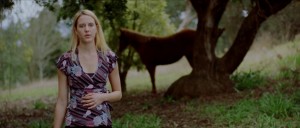Warren Lynch has graded on huge hollywood films such as Lord of the Rings, but with his new company he has also engineered interesting approaches to indie feature digital grading. In this week’s podcast we discuss diamonds in vodka, 2 perf, bleach by-pass, and more
Puppy is the debut feature for writer/director Kieran Galvin an offbeat love story shot and posted in Australia. Melissa Beauford the producer chose Intercolour, the official digital intermediate facility on the Fox Lot in Sydney where she had color corrected the movie “Feed†for its debut in Cannes in 2005.
 Intercolour, under the guidance of founder and Senior Colorist, Warren Lynch, has helped out many small films, including Puppy. This 35mm indie picture is a particularly good example of how even small films can get a full DI treatment. Made on a tight budget and shot in 20 days, the film is an official selection of the Brisbane International Film Festival, the Singapore International Film Festival, the London Australian Film Festival, South by Southwest, and numerous other prestigious venues.
Intercolour, under the guidance of founder and Senior Colorist, Warren Lynch, has helped out many small films, including Puppy. This 35mm indie picture is a particularly good example of how even small films can get a full DI treatment. Made on a tight budget and shot in 20 days, the film is an official selection of the Brisbane International Film Festival, the Singapore International Film Festival, the London Australian Film Festival, South by Southwest, and numerous other prestigious venues.
Puppy is an unconventional love story that follows a young woman named Liz, who, after a very bad day spent looking for a job and running over her own dog, ends up drunk on the streets at night. She is “rescued†by a good-looking man, Aiden, who is off the medication that normally prevents him from having delusions. He takes Liz to his remote house in the country, believing that Liz is his wife. Liz plays along. So begins a quirky romance that soon becomes a much darker relationship. The filmmakers have described their film as a story about madness, dependency, and deception.
Creating a digital intermediate for an extremely low budget film is unusual because of the expense of both the film scanning and film output. This alone costs tens of thousands of dollars, not including the actual DI work. Intercolour’s frequent partners, Speed Wedge film recording house and Movielab Sydney, worked out a deal that allowed Puppy’s producer, Melissa Beauford, to finish the indie project in a manner more typical of productions with triple Puppy’s budget.
 Puppy was shot on two-perf Techniscope using half the normal 35mm frame while still delivering a full 2.35:1 aspect ratio at a considerable cost savings in film. (Listen to the podcast for more on this process). The new Intercolour facility is fully equipped for both 35mm and HD productions in all format that can be projected in a the main digital intermediate suits. Once the film was scanned, Lynch color corrected the film using Nucoda software on Windows-based systems. In Intercolour’s main color correction suite, cinematographers and directors make decisions on HD calibrated monitors, but can also project 35mm reels or screen on an HD projector in the same room. While color correction on a DI system typically means highly flexible shot-to-shot and scene-to-scene full frame correction, Lynch is also able to interpret color in all or part of a frame and provide visual stylization far beyond what is possible with traditional Hazeltine timing at the lab. This often spills over into VFX work (also provided in-house), including sky replacement, slow motion FX, titles, and sophisticated tracking of motion shots for day-for-night work and general image enhancement.
Puppy was shot on two-perf Techniscope using half the normal 35mm frame while still delivering a full 2.35:1 aspect ratio at a considerable cost savings in film. (Listen to the podcast for more on this process). The new Intercolour facility is fully equipped for both 35mm and HD productions in all format that can be projected in a the main digital intermediate suits. Once the film was scanned, Lynch color corrected the film using Nucoda software on Windows-based systems. In Intercolour’s main color correction suite, cinematographers and directors make decisions on HD calibrated monitors, but can also project 35mm reels or screen on an HD projector in the same room. While color correction on a DI system typically means highly flexible shot-to-shot and scene-to-scene full frame correction, Lynch is also able to interpret color in all or part of a frame and provide visual stylization far beyond what is possible with traditional Hazeltine timing at the lab. This often spills over into VFX work (also provided in-house), including sky replacement, slow motion FX, titles, and sophisticated tracking of motion shots for day-for-night work and general image enhancement.
As the director Galvin Kieren explains, he was interested in much more then typical scene-to-scene color correction and wanted to use the greater flexibility of digital technology to tell the story, “We created a bleached bypass white contrast look for a part of the film to denote that it is a flashback. It’s such a different look to the rest of the film that we didn’t have to suggest it in any other way. Emotionally, this mirrored the main character’s life at that time in the story, taking its cues from the pebble dashed high rise inner city government housing blocks. We also used some hypercolour ‘glowing’ effects on candles and other magic realist scenes.â€
One of the advantages that makes Intercolour a first stop for many indie filmmakers is Lynch’s experience in using desktop solutions combined with traditional dedicated color systems. To help build a production pipeline held to the highest 4:4:4 data stream while keeping the system cost-effective, Lynch uses Blackmagic Design Cards (BMD) for his I/O solutions for both Mac and PC systems. The Blackmagic cards was critical. As Lynch points out, “All footage for Puppy was maintained and previewed in 10-bit LOG color space using the DeckLink card. One of the advantages of BMD is that there are many options for codecs throughout the process and their codec & driver development is extremely fast.â€
Desktop solutions provide such a lower cost point that Intercolour can provide Di grading on films which normally would not even consider a DI path. The facility is built on PCs and G5, some Nucoda others using Final Touch. He uses BMD HD DeckLink cards for capture from SD and HD VTRs and routes signals through a BMD Multibridge to decode eight tracks of sound for Dolby 5.1 monitoring in the color grading theater. Not so long ago, the infrastructure required to handle HD data streams would have been so costly that it would have been impossible to take the time digitally color correct a film like Puppy. As Lynch explains, “The Blackmagic HD DeckLink card has simply been a breath of fresh air in my business. Compared to the extremely overpriced alternatives I have experienced in the past, the Blackmagic kit works well and is seriously reliable and provides operational versatility.â€

Puppy’s filmmakers also had the option of using the screening rooms on the Fox lot with access to state-of-the-art digital projectors, including a 2K Black Chip projector. Intercolour is unique in its understanding of providing both 35mm output and a digital cinema print, a particularly tricky delivery item since digital cinema standards have not been fully implemented worldwide. This turned out to be particularly important for Puppy, because its initial release will, in fact, be in digital cinemas
